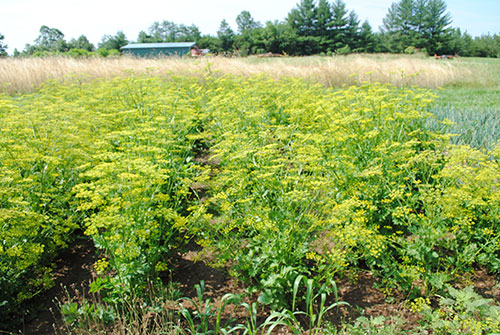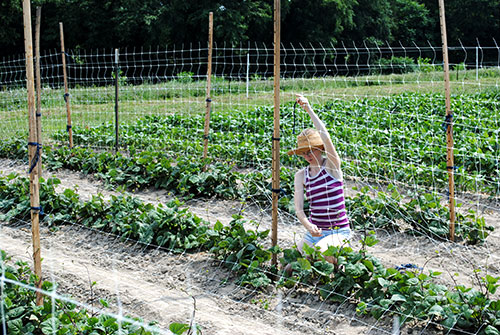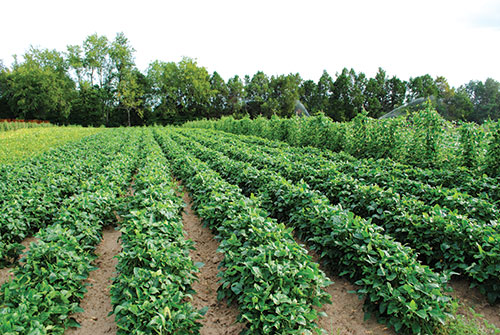by Debbie Piesen
Garden planning can be a complicated business. But for most home gardens, your main concerns are fitting everything in the most space efficient way, rotation, and planning for succession planting. These factors are covered by Southern Exposure’s Garden Planner, a very useful tool for the small scale home grower.
When we start to scale up to a larger garden or farm, however, there are more factors to consider. Is the texture or fertility of your field(s) better suited to particular crops? For example, you might want to plant un-irrigated crops like field corn in a low lying field, where the soil stays moister naturally, or make sure heavy nitrogen feeders follow a successful legume cover crop. You may need to think about truck access for heavier crops like watermelons, and try to match your cultivation techniques to your weed pressure (for example, no-till methods don’t work as well in areas of where you have a lot of aggressive weed seeds in the soil, or perennial weeds).
All these considerations and more need to go into planning our seed growing fields at Living Energy Farm. When growing crops for seed, we also need to plan for isolation distance, to prevent crossing different varieties of the same species; and population size, to ensure enough diversity to maintain genetic vigor. These two issues are related. Generally, some plants are self-pollinated, and will happily pollinate their own flowers, and some are outcrossing, meaning they will hold out for pollen from another plant before setting fruit. Certain self pollinating plants like tomatoes and beans only need an isolation distance of about 50 feet for home scale seed saving. Because these plants mostly pollinate themselves, ten individual plants should be enough to maintain genetic vigor, although you may want to start with more if you plan to do any selection. These are good crops for the beginner seed saver. (To make things more complicated, there are some crops, like okra, that will readily outcross if given the chance but can also pollinate themselves. There plants need an isolation distance of a half mile, but don’t need a huge population size to save seed.)
Plants that outcross by wind or by insect pollinators include corn, members of the cucurbit family (squash, melons, cucumbers, gourds), beets, celery, and members of the brassica family (cabbage, broccoli, kale, kohlrabi, turnips, radishes). Generally, these crops need a population of around 80 individuals to maintain vigorous seed. (Exceptions abound: corn needs about 200 individuals, and cucurbits are not particularly susceptible to inbreeding depression, and can get away with 10-20 individuals). These plants require a minimum isolation of a half mile to ensure pure seed. This kind of isolation distance can be tricky to maintain. Be sure to talk to your neighbors. If you have a neighbor who grows a garden with outcrossing crops, you may want to offer them some of your seed so they will grow the same varieties as you.
If you must have two varieties of the same species closer than a half mile, here are some tricks of the seed saving trade that can cut down on minimum isolation distance. If you plant in blocks instead of rows, and only harvest seed from the middle of the block, this can help maintain pure seed. This method is especially effective with corn. Physical barriers such as rows of trees or buildings will reduce crossing to some extent. The use of barrier crops is effective with insect pollinated crops like squash. A barrier crop is a plant, like buckwheat, placed between your seed crops and timed to flower at the same time as your seed crop to distract the insects that might be flying between your fields.
We have also experimented with time isolation. This means to stagger planting times so that your varieties bloom at different times and cannot pollinate each other. This can be tricky, though. Most plants grow much faster when it is warm, so late planted crops can often "catch up" with early plantings as the weather warms up. A gap in planting time of three weeks can end up with a gap in flowering time of one week or less. But this technique is worth a try, especially for home scale seed saving where a minimal amount of crossing might be acceptable.
Planning a garden for seed saving sounds complicated, but the rewards are abundant. Start with an easier crop like peas or tomatoes and work your way up. Use resources such as Organic Seed Alliance Seed Saving Guide and the Saving Our Seeds organic seed production manuals.
Good luck and happy spring!



